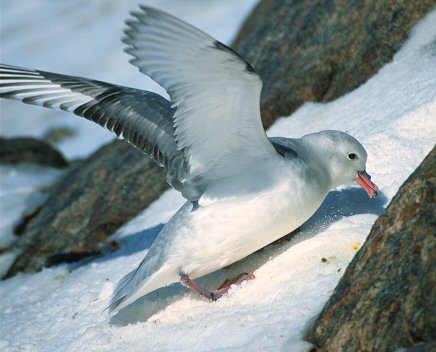|
| 질의: Fossil | 결과: 1230번째/1405 | |
Fulmar (Genus: Fulmarus) - Wiki
| 제목: | Fulmar (Genus: Fulmarus) - Wiki
| |

| 해상도: 436x352
파일크기: 35781 Bytes
등록시간: 2007:12:12 11:13:39
|
Fulmar
From Wikipedia, the free encyclopedia
Order: Procellariiformes
Family: Procellariidae
Species: Fulmarus glacialis, Fulmarus glacialodes
[Photo] An Antarctic Fulmar (or Southern Fulmar, Fulmarus glacialoides) removing the snow from its nest after arriving in spring. Author: ?? 1993-2007 Guillaume Dargaud (www.gdargaud.net). Source: www.gdargaud.net/Antarctica/Birds.html
The two Fulmars are closely related seabirds occupying the same niche in different oceans. The Northern Fulmar (Fulmarus glacialis), or just Fulmar lives in the north Atlantic and north Pacific, whereas the Southern Fulmar (Fulmarus glacialoides) is, as its name implies, a bird of the southern oceans. These birds look superficially like gulls, but are unrelated, and are in fact petrels. The northern species is grey and white with a yellow bill, 43-52 cm in length with a 101-117 cm wingspan. The southern form is a paler bird with dark wing tips, 45-50 cm long, with a 115-120 cm wingspan.
Two prehistoric species have been described from fossil bones found on the Pacific coast of California: Fulmarus miocaenus from the Middle and Fulmarus hammeri from the Late Miocene.
Both Recent species breed on cliffs, laying a single white egg. Unlike many small to medium birds in the Procellariiformes they are neither nocturnal breeders, nor do they use burrows;their eggs are laid on the bare rock or in shallow depressions lined with plant material. Nesting birds and chicks can eject an evil smelling stomach oil up to 2 m, which repels unwanted visitors. It will matt the plumage of avian predators, and can lead to their death. Northern Fulmars historically bred on St. Kilda, and spread into northern Scotland in the 19th century, and to the rest of the United Kingdom by 1930. For example, establishment of colonies at the Fowlsheugh Reserve in Scotland was one of the first areas to be developed for new permanent Fulmar breeding areas.
They are highly pelagic outside the breeding season, like most tubenoses, feeding on fish, oil or offal. Recent studies in the North Sea have shown them especially susceptible to plastic discards. The range of these species increased greatly last century due to the availability of fish offal from commercial fleets, but may contract because of less food from this source and climatic change. The population increase has been especially notable in the British Isles.
Like other petrels, their walking ability is limited, but they are strong fliers, with a stiff wing action quite unlike the gulls. They look bull-necked compared to gulls, and have short stubby bills. They are long-lived, with a lifespan of 40 years not uncommon.
http://en.wikipedia.org/wiki/Fulmar
| The text in this page is based on the copyrighted Wikipedia article shown in above URL. It is used under the GNU Free Documentation License. You may redistribute it, verbatim or modified, providing that you comply with the terms of the GFDL. |
|
^o^
동물그림창고 똑똑전화 누리집
^o^
|
|